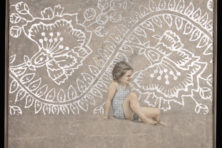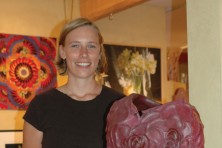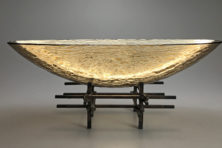Inspiration in the Trees: Stephanie Evans’ new work at Fine Line Designs
- Share
- Tweet
- Pin
- Share

Stephanie Evans creates ceramic sculptures of dresses and occasionally of flowers. For her new show at Fine Line Designs Gallery, the Sister Bay artist found inspiration among the trees.
“Making this body of work, I spent a lot of time out in the woods,” she said. “I love going into the woods after a rain, looking at all that moss and the bark. When you walk up to a tree and you really look at the bark, there are a million different colors in there, and it’s just beautiful.”
To capture that beauty in her tree-dress sculptures, Evans presses clay against the tree she’s chosen for her model.
“I’ll take rubbings of the tree to get the texture, and then I build up the pieces as a whole and roll out really thin slabs and add them to the piece, the way a woodworker would put a veneer on,” she explained. “The tricky part is to make the tiny pieces all blend together.”
Evans’ ash-tree dress is enlivened by touches of Door County spring – ferns, trilliums and morel mushrooms.
“This piece is kind of about beginnings and endings,” she said. “All these ash trees are going to go away. It’s a continuous cycle.”
Her cedar piece is based on the trees she sees from the Eagle Trail in Peninsula State Park. The sculpture is decorated with cedar sprays made of clay and painted green, and the roots are wrapped around rocks that are also made of clay.
“The stones give the tree something to hold on to, and at the same time, the roots are helping hold the rocks – a symbiotic relationship,” Evans said.
An oak dress is decorated with brightly colored leaves, and she sees a message there, too.

Art by Stephanie Evans. Submitted. 
Art by Stephanie Evans. Submitted. 
Art by Stephanie Evans. Submitted.
“If oak trees were to keep their leaves in the winter, it would actually cause them harm from the weight of snow,” she said. “So the oak dress is about letting go of what doesn’t serve you anymore. It’s beautiful, with the red and gold leaves that we all love and admire. They’re wonderful, and now the tree is getting ready to release them because it knows that the leaves are going to weigh it down.”
Eventually, Evans plans to do a dress sculpture with birch.
“I haven’t figured it out because it’s such a smooth texture,” she said. “That very delicate paper curl – I want to be able to achieve that, but I also have to be mindful about not making things that are too fragile.”
Most of Evans’ dresses have been solid shapes, but she did some pieces cast in clay with help from Juddville-based glass artist Deanna Clayton that were cages that held a light bulb.
“The light-bulb pieces were political work for me because I made those two pieces during the time of Trump’s election, which was very unsettling for me,” she said. “I did those light-bulb pieces and lanterns because it was all about trying to find the light, trying to find light in the darkness.”
She builds her dresses using the coil method with no molds, so each dress is unique, with rich surfaces created by layering slips, underglazes, paint and wood stains. Creating the dress sculptures can take four to seven weeks.
For much of her work, Evans imagines the character who wore the dress she has designed and creates a backstory. She does something similar with trees, giving them personality and agency – the ability to act – like the oak shedding leaves in the autumn to avoid getting weighed down by snow.
She has loved learning about the ways trees can communicate underground through their roots, and her appreciation of the natural world comes through as she celebrates trees in her work.
Debra Reid Jenkins

Art by Debra Reid Jenkins. Submitted.
A Glidden Drive resident said an oil painting of Lake Michigan by Debra Reid Jenkins looked just like the view from her house, even though Jenkins paints the other side of the lake.
She lives an hour east of the lake in Lowell, Michigan, but she said she can read its light just by looking up at the sky from her home.
“Surf’s up – you’re on your own for dinner,” Jenkins tells her husband when the light looks promising. Then she heads to the lake with a Canon EOS 90D DSLR.
“I did plein air painting almost daily for five or six years,” she said. “I got tired of it because it just got to a point where everything was looking the same to me.”
Now Jenkins starts her paintings with photographs.
“Say it’s a day of stormy weather,” she explained. “I will go out with a camera and hike up and down the shoreline and do tons of shots, shooting until dark. Then I come back and print the images I like, lay them out on a table and take a little bit of this and a little bit of that. As a painter, my goal is to capture specific moments in time on canvas.”
Cameras don’t always record the colors she wants, “but I have a photographic memory,” Jenkins said. “After years and years of observation, I could shoot it in black and white and still know what the colors are.”
Then she goes to work painting, drawing on her study of how human brains and eyes work, she said.
“Close up, it will look like a bunch of blobs, and then when you walk back 10 or 12 feet, it will all come together like a slide coming into focus,” Jenkins said. “I take an idea and create a composition of how the eye is going to move around in it. The physicality of the paint helps lead the eye around.”
Pamela Murphy

Mechanics by Pamela Murphy. Submitted. 
Secluded by Pamela Murphy. Submitted.
Pamela Murphy’s work has long been focused on the artist’s collection of old photographs, whose figures she chooses as the basis for her paintings.
“The people whose lives are recorded in those pictures are strangers to us, yet at the same time, there’s a familiarity,” she said. “They remind us of ourselves, our families and our issues – on levels that are both personal and cultural.”
Murphy presents her figures on rich and textured surfaces, with many layers of paint to reveal the history of the canvas and isolate the form of each figure.
“The viewer can then bring their own specific history to the painting, so a single image can mean different things to different people,” she said. “The goal is for the viewer to find a little of themselves in the work.”
In late June, Murphy was planning a naming party for her paintings.
“I have about 10 people with food and lots to drink, and we name the paintings,” she said.



